The carnage or to put it more precisely the anti Muslim violence in Delhi (February-March 2020) has shaken us all. Analysts are burning midnight oil yet again to understand the deeper causative factors of the same.
One of the neglected aspects of analysis of communal violence has been the one related to prevalent factor of Caste in Indian society. Caste is inherent in the scriptures called as Hindu scriptures; caste has been the rigid frame work of Hindu society, which has also penetrated into other religious communities in India.
The deeper connection between Hindu nationalism or Hindutva and caste has been explored somewhat but not too many studies have taken up the relationship between the communal violence and caste in India.
Suraj Yengde (IE, Delhi Pogrom is an attempt to Divert attention from Government’s Failures, March 8, 2020) makes some points on this issue. Yengde points out, “Many are still downplaying the Delhi riot as an affliction of Hindutva or Hindu-Muslim binaries. It is neither. It is not religious but caste tensions that encourage such treacherous acts.”
He quotes from the Gujarat activist Raju Solanki, “in the 2002 Godhra riots there were 2,945 arrests in Ahmadabad. Of these, 1,577 were Hindus and 1,368 Muslims. Among the Hindus arrested, 797 were OBCs, 747 Dalits, 19 Patels, two Baniyas, and two Brahmins. The upper castes became MLAs, the rest were jailed. Also, it is not an accident that Dalits constitute nearly 22% of the total arrests in India; Adivasis 11%, Muslims 20% and OBCs 31%. More than 55% of under trials also come from the same communities (NCRB 2015).”
While this data is on the dot it must be stated that while caste has lot of role in the emergence of politics of Hindutva, in the resultant violence the primary focus has been religion, here caste plays a role which is secondary in some ways.
To trace the outline of the Hindu nationalism’s prime mover RSS; one can definitely say that its formation and rise is primarily due to the rising caste consciousness and the beginnings of struggles aimed at injustices due to the caste Varna System. While Hindu Mahasabha was already on the scene as parallel and opposite to the Muslim League, these formations initially had only Kings and landlords. Later these formations were joined in by some elite, affluent sections of society.
RSS in particular was a response to the ground level changes resulting in coming up of low caste/average people in social and political space. It was the non-cooperation movement led by Gandhi and then the non Brahman movement in Nagpur-Vidarbha area which disturbed the Brahmanical sections, supported by landlord-kings, to take up the agenda of Hindu nation. The core articulation of Hindutva politics was to present the glorious ancient times, when Manu Smriti’s laws ruled the roost. These were getting a jolt now as the efforts of Joti Rao Phule and later the campaigns of Ambedkar started empowering the downtrodden dalits. This was a serious threat to Brahmanical system.
While this was the core an external threat was to be created to ‘unify’ Hindu society. And here the Muslims, Muslim Kings rule came in as handy. It is this anti Muslim tirade and actions which was the frontage for Hindutva, while the anti dalit-agenda was the real underlying motive. The whole of Shakha (RSS branches) baudhiks (intellectual sessions) were structured around this. The promotion of communal historiography, the hatred for Muslims was the visible part of RSS training, while glorification of past is the fulcrum which in a way is the code language for retaining the hierarchy of caste and also of gender.
Practically also if we see the strengthening of Hindutva began on the issue of a Muslim king destroying the temple of the birth place of Lord Ram, this campaign got its vitriol after the implementation of Mandal Commission in 1990. The anti Muslim Hate and promotion of values of caste and gender hierarchy are synthesized by Hindutva politics. That’s as far as the political agenda of Hindu nationalism goes. As far as communal violence is concerned, it has been an anti Muslim work through and through. All the statistics shows that victims of communal violence are primarily Muslims, around 80% of victims being Muslims. These Muslims do come from all sections of Muslims, more from the poor.
The caste comes into operation in the mechanism of riot production. Hindutva politics, through its extensive network has been working relentlessly among dalits. The recent book by Bhanwar Meghwanshi, “I was a Kar Sevak”, brilliantly describes the mechanism of co-opting dalits into the agenda of sectarian politics. RSS has floated innumerable organizations, like Samajik Samrasta Manch, which work among dalits to promote Brahmanical values and to integrate dalits into the scheme of Hindutva politics. They are made to act as foot soldiers of Hindu nationalist politics. Those who spread hate through indoctrination and propaganda are safe in their cozy houses or offices while the poor dalits are made to soil their hands with the blood of religious minorities.
The face of Gujarat violence, Ashok Mochi, now talks of dalit-Muslim unity. The data compiled by Raju Solanki and quoted by Yengde is the norm in the cases of violence in India. Those who are incited, those who are later charged with violence are not the ones who give donations to RSS or support its various activities. Most of these do come from the sections of indoctrinated youth from downtrodden communities.
Yengde has done a valuable job in drawing our attention to the role of caste in communal violence; the problem with his thesis is the undermining the role of ‘Hate against religious minorities’, which is the base on which the violence is orchestrated. The extent and degree of indoctrination done through shakhas is very powerful and effective. This can gauzed from the experiences of the likes of Bhanwar Meghwanshi, who tells us the difficulties he had to face to come to grips of reality of caste while overcoming the RSS propaganda.

 When Munaz decided to send her cover version of 'Zaalima' from the Bollywood movie 'Raees' to this initiative three months ago, little did she expect that she would be featured in the final video compilation. Along with Munaz, the video features covers of 'Zaalima' , 'Afreen' and 'Sajde Kiye Hain Lakhon' sung by other Indians and Pakistanis, and two singers from Qatar and USA.
When Munaz decided to send her cover version of 'Zaalima' from the Bollywood movie 'Raees' to this initiative three months ago, little did she expect that she would be featured in the final video compilation. Along with Munaz, the video features covers of 'Zaalima' , 'Afreen' and 'Sajde Kiye Hain Lakhon' sung by other Indians and Pakistanis, and two singers from Qatar and USA.




Comments
wow nice to hear! festival for ears.
Young Girl ! it would be better for you to recite your lord's word instead of film songs... God has given you a beautiful voice. please contemplate on reciting the word of God. Make a video of your lord's word so that many people who are unaware of their creator will know thru your beautiful voice.
Add new comment